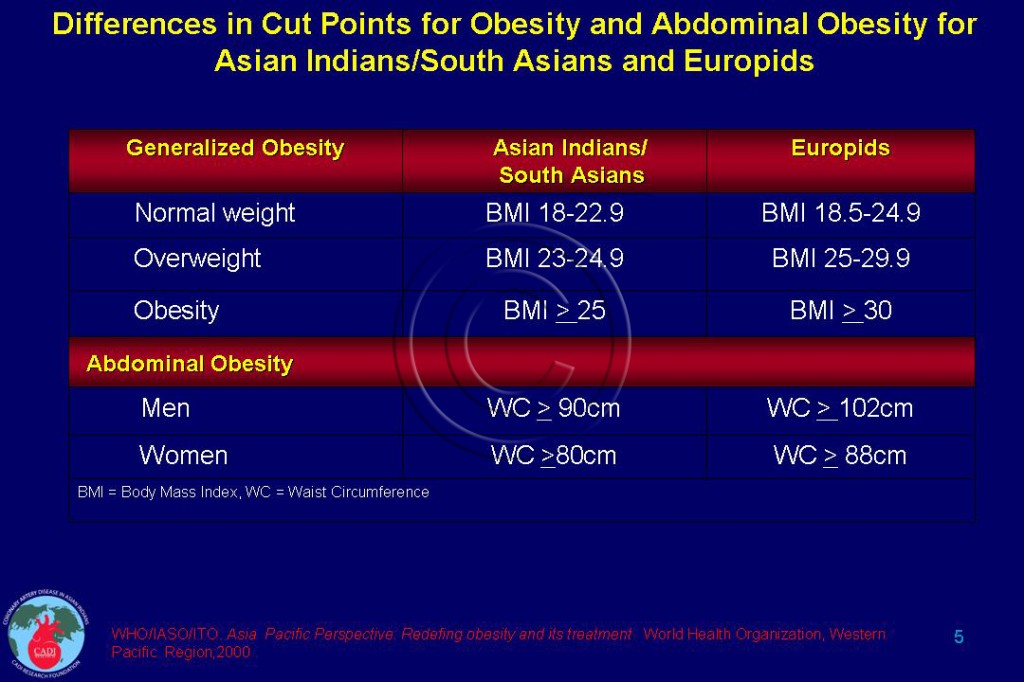Obesity in Pakistan
- According to World Health Organization (WHO) estimates, 26 % of women and 19% of men in Pakistan are obese (Body Mass index (BMI) > 25) but only 4% of women and 1 % of men are recognized as obese using the standard criteria (BMI > 30). The prevalence of obesity is even higher in urban areas (56% in men and 67% in women) when Asian specific definitions for obesity (Table 005) is used.1
- A recent study found high rates of underestimation of overweight and obesity among Pakistanis;
- 52 % of overweight and 73% of obese people thought they were normal weight.2
- Appropriate perception of weight status and awareness of the dangers of obesity and the benefits of weight loss are a prerequisite for weight loss efforts and its success.3 Advice given to obese people to lose weight may go unheeded if they consider themselves normal weight.4
- Traditionally body weight has been regarded as a symbol of health, prosperity and wealth in various populations especially South Asians.5 They would, therefore, tend to accept overweight/obesity as a norm and are thus at a higher risk of not perceiving it to be of any concern.2
- Increased prevalence of obesity in older age groups, is usually accepted as an age related phenomenon.6 This is a cause of concern because accumulation of risk factors with advancing age can increase the likelihood of chronic diseases.6
- Presence of comorbid conditions lead to increased susceptibility and thus increased awareness of being obese, but not so among Pakistanis probably because people with hypertension, dyslipidemia, diabetes mellitus focused more on their primary diseases than on obesity. 2
- The weight misperception appears to be equally true among physicians because 64% of obese Pakistanis were not advised of their weight by their doctors let alone advised to loose weight
- This weight misperception along with unhealthy life styles contributes to development and progression of chronic disease and makes it imperative that the high risk groups correctly perceive their weight and take appropriate action.
- Greater body size satisfaction is associated with healthy lifestyle behavior and less weight gain in later years in children and adolescents. 2 Other studies have shown the impact of satisfaction with their body size on weight loss efforts. Women who were not satisfied with their body size were approximately nine times and women who were satisfied with their body size were three times more likely to try to lose weight as compared with women who were very satisfied with their body size.7
- Health professionals have an obligation to correctly identify obese people, educate them about the health risks of obesity and advise them about appropriate strategies for weight loss. Concerted efforts need to be undertaken to prevent weight gain by emphasizing healthy eating habits and adequate exercise in children, adolescents and adults.
- Being overweight (BMI = 23-24.9) is a major health risk among all South Asians.8 It is a precursor to obesity and it is relatively easier to lose weight at these moderate levels than at higher levels of weight gain. Thus overweight people should be educated about the associated health risks of being overweight which occurs at a much lower BMI in South Asians than Europids.8
- The prevalence of overweight and obesity, weighted to the general Pakistani population, was 25% and obesity 10% in Pakistan in a large study.8
- The Pakistani studies indicate optimal identification of those at risk of hypertension and diabetes and healthy targets may require the use of even lower BMI cutoff values than those already proposed for an Indo-Asian population.8
Sources
1. WHO/IASO/ITO. Asia Pacific Perspective:Redefing obesity and its treatment World Health Organization, Western Pacific Region;2000.
2. Bhanji S, Khuwaja AK, Siddiqui F, Azam I, Kazmi K. Underestimation of weight and its associated factors among overweight and obese adults in Pakistan: a cross sectional study. BMC Public Health. May 23 2011;11(1):363.
3. Lemon SC, Rosal MC, Zapka J, Borg A, Andersen V. Contributions of weight perceptions to weight loss attempts: differences by body mass index and gender. Body Image. Mar 2009;6(2):90-96.
4. Kuchler F, Variyam JN. Mistakes were made: misperception as a barrier to reducing overweight. Int J Obes Relat Metab Disord. Jul 2003;27(7):856-861.
5. Cassidy CM. The good body: when big is better. Med Anthropol. Sep 1991;13(3):181-213.
6. Grundy SM. Multifactorial causation of obesity: Implications for prevention. Am J Clin Nutr. 1998;67(3 Suppl):563S-572S.
7. Anderson LA, Eyler AA, Galuska DA, Brown DR, Brownson RC. Relationship of satisfaction with body size and trying to lose weight in a national survey of overweight and obese women aged 40 and older, United States. Preventive medicine. Oct 2002;35(4):390-396.
8. Jafar TH, Chaturvedi N, Pappas G. Prevalence of overweight and obesity and their association with hypertension and diabetes mellitus in an Indo-Asian population. CMAJ. Oct 24 2006;175(9):1071-1077.


